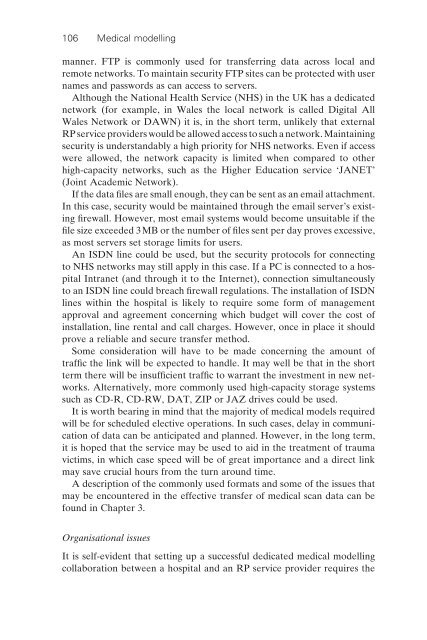R_Bibb_Medical_Modelling_The_Application_of_Adv.pdf
R_Bibb_Medical_Modelling_The_Application_of_Adv.pdf
R_Bibb_Medical_Modelling_The_Application_of_Adv.pdf
Create successful ePaper yourself
Turn your PDF publications into a flip-book with our unique Google optimized e-Paper software.
106 <strong>Medical</strong> modelling<br />
manner. FTP is commonly used for transferring data across local and<br />
remote networks. To maintain security FTP sites can be protected with user<br />
names and passwords as can access to servers.<br />
Although the National Health Service (NHS) in the UK has a dedicated<br />
network (for example, in Wales the local network is called Digital All<br />
Wales Network or DAWN) it is, in the short term, unlikely that external<br />
RP service providers would be allowed access to such a network. Maintaining<br />
security is understandably a high priority for NHS networks. Even if access<br />
were allowed, the network capacity is limited when compared to other<br />
high-capacity networks, such as the Higher Education service ‘JANET’<br />
(Joint Academic Network).<br />
If the data fi les are small enough, they can be sent as an email attachment.<br />
In this case, security would be maintained through the email server’s existing<br />
fi rewall. However, most email systems would become unsuitable if the<br />
fi le size exceeded 3 MB or the number <strong>of</strong> fi les sent per day proves excessive,<br />
as most servers set storage limits for users.<br />
An ISDN line could be used, but the security protocols for connecting<br />
to NHS networks may still apply in this case. If a PC is connected to a hospital<br />
Intranet (and through it to the Internet), connection simultaneously<br />
to an ISDN line could breach fi rewall regulations. <strong>The</strong> installation <strong>of</strong> ISDN<br />
lines within the hospital is likely to require some form <strong>of</strong> management<br />
approval and agreement concerning which budget will cover the cost <strong>of</strong><br />
installation, line rental and call charges. However, once in place it should<br />
prove a reliable and secure transfer method.<br />
Some consideration will have to be made concerning the amount <strong>of</strong><br />
traffi c the link will be expected to handle. It may well be that in the short<br />
term there will be insuffi cient traffi c to warrant the investment in new networks.<br />
Alternatively, more commonly used high-capacity storage systems<br />
such as CD-R, CD-RW, DAT, ZIP or JAZ drives could be used.<br />
It is worth bearing in mind that the majority <strong>of</strong> medical models required<br />
will be for scheduled elective operations. In such cases, delay in communication<br />
<strong>of</strong> data can be anticipated and planned. However, in the long term,<br />
it is hoped that the service may be used to aid in the treatment <strong>of</strong> trauma<br />
victims, in which case speed will be <strong>of</strong> great importance and a direct link<br />
may save crucial hours from the turn around time.<br />
A description <strong>of</strong> the commonly used formats and some <strong>of</strong> the issues that<br />
may be encountered in the effective transfer <strong>of</strong> medical scan data can be<br />
found in Chapter 3.<br />
Organisational issues<br />
It is self-evident that setting up a successful dedicated medical modelling<br />
collaboration between a hospital and an RP service provider requires the
















